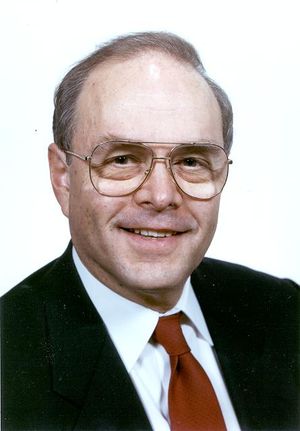Robert L. Hartman
- Birthdate
- 1936/05/03
- Birthplace
- New York, NY, USA
- Associated organizations
- Bell Labs
- Fields of study
- Semiconductors
- Awards
- IEEE Medal for Engineering Excellence
Biography
Robert Louis Hartman was born in New York City on May 3, 1936. He obtained the B.A. degree in Mathematics from Columbia College in 1958, the B.S. in engineering Physics from Columbia University School of Engineering in 1958, and the M.S. and Ph.D. degrees in Physics from Columbia University, Graduate Faculty in 1961 and 1968, respectively. In 1962, he was appointed a member of the Graduate Faculty, Department of Physics, Columbia University. From 1963 to 1968, he worked at IBM T. J. Watson Laboratories, publishing papers on optical and electromagnetic properties of semiconductors and semimetals.
In 1968, Dr. Hartman joined AT&T Bell Laboratories, Inc. as a member of the Technical Staff. At first he continued studies of the electronic properties of materials, publishing studies of radiative recombination in SiC, but he soon focused on exploring the causes of degradation in III-V compound semiconductor light-emitting diodes and lasers. This was the time when the first room-temperature operation of a semiconductor laser was reported at Bell Laboratories, and the potential use of these devices in electronics and optical communication was exciting. Unfortunately these devices were laboratory novelties, with operating lifetimes measured only in seconds, or at most, minutes. Dr. Hartman, collaborating with others at Bell Laboratories, discovered and published in 1973: that the degradation in semiconductor lasers was caused by the growth of dark-line-defects (DLDs) (reported in one of the most often cited papers in the literature of semiconductor lasers; that strain was a significant factor in promoting this degradation and lifetimes could be improved two orders of magnitude with reduced bonding strain; and that, with improvements in the fabrication procedures, these lasers could operate hundreds of hours.
Dr. Hartman followed these studies with publications which showed that DLDs are caused by point defect (vacancy) accumulation, a climb mechanism, and proposed means of inhibiting the growth of DLDs. He continued with reports analyzing the effects of the degradation on the properties of semiconductor lasers and published the first measurement of the thermal acceleration of the lifetime of these lasers. These studies and the ongoing work of others at Bell Laboratories resulted in the demonstration of highly reliable semiconductor lasers.
In 1980, Dr. Hartman became a Supervisor of a semiconductor laser development group. This group has led in the development of high reliability lasers with the invention of the purge procedure and improved laser design. These lasers are being used successfully in AT&T's extensive Undersea and Terrestrial Lightwave Systems. More recently, he was leading efforts which have developed reliable, high-speed multiquantum well lasers for optical communications.
Dr. Hartman has published 59 scientific papers and 12 issued patents. He has coauthored and was technical editor of a book on the reliability of lasers for Submarine Lightwaves Systems. He was a Fellow of the IEEE and a member of the American Physical Society and received the 1993 IEEE Medal for Engineering Excellence.
He was married to the former Monica Lucia Ruth Deutsch; they had two sons, Edward, and David. His outside interests included music, history, photography, travel and tinkering.
